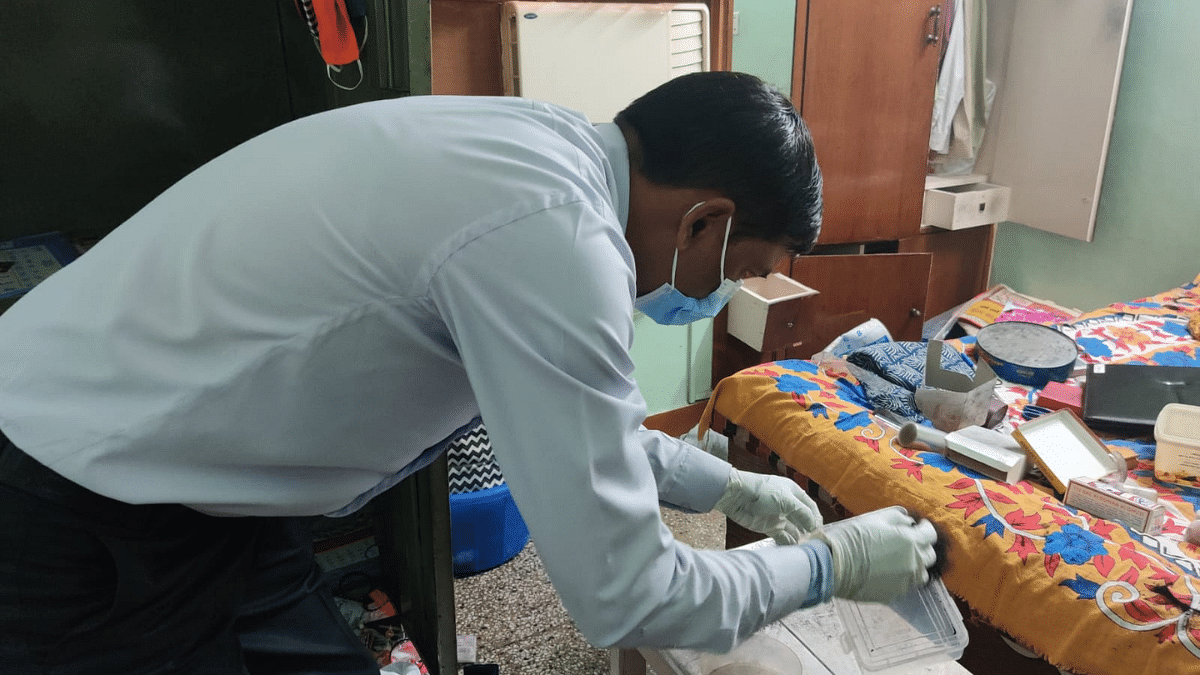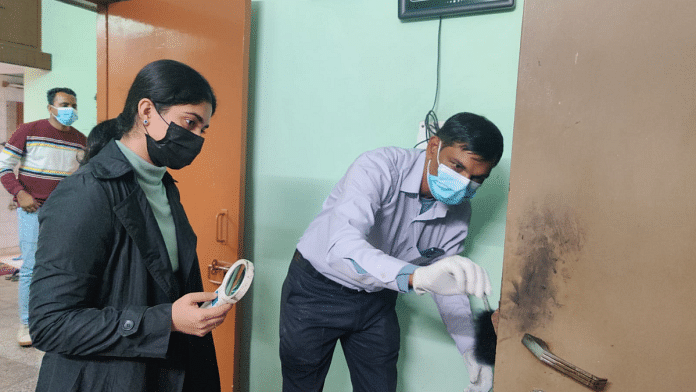New Delhi: Inside a ransacked house, Chitra tags every item that can possibly have fingerprints and clues. She follows it by making a list of the tagged items. Ravi Kant then carefully makes a clean sweep of all the tagged items, and looks through the magnifying glass.
Two other police officers also hunt for clues at the crime scene. It will take Ravi at least two hours to lift all the fingerprints and collect other evidence from the house, where burglars descended when the owner was out the previous night.
Both Chitra and Ravi are part of the Delhi Police’s mobile forensics teams that have given a renewed thrust to crime scene investigation. They had rushed to the crime spot at a locality in East Delhi after the control room forwarded a burglary complaint to the Pandav Nagar police station.
Specialising in ballistics, Chitra has been working with one of these teams for the past three years. The forensic expert was hired from the National Institute of Forensic Sciences (NFSU) in Gujarat.
In her role as a general forensic assistant, she travels in a mobile forensic van (MFV) deputed for East Delhi district. The van trails the mobile forensic team that lifts samples from the crime spot.
Ravi, a fingerprint expert, has been with the Delhi Police for two decades. A Master’s degree holder in Organic Chemistry, he works with the fingerprint bureau of the Crime Branch.

Working in shifts lasting at least nine hours, the two often travel in a MFV that zips past vehicles on the road to reach crime spots at the earliest for gathering evidence.
Back at the ransacked house, a preliminary search reveals that the burglars had locked the neighbour’s door from the outside. The break-in came to light after the neighbour noticed that the front lock of the robbed house was broken. A PCR call was made, and the owner alerted.
Turns out that the burglars got away with all the gold jewellery in the house. “The jewellery belonged to the daughter. The family lives in Mathura, and the daughter had also gone there for a visit. We are scanning CCTV footage and looking at other clues,” a senior police officer said.
Small step, giant leap
A year ago, the Delhi Police decided to procure 15 MFVs from Gandhinagar-based NFSU. The purpose was to ensure that there is no tampering of forensic evidence, identification, and its packaging.
Now, all the 15 police districts in Delhi has MFVs equipped with 14 kits for fingerprint-collection, forensic light sources, blood & semen detection, sexual assault investigation, explosives detection, narcotics testing, gunpowder detection, bullet hole testing and arson investigation among others.
Union Home Minister Amit Shah has reiterated several times to make forensic examination of crime scenes “compulsory and legal” in all cases that entail a punishment of more than six years.
The MFVs reached 1,621 crime scenes, 1,495 in Rohini, 1,173 in Shahdara, 1,831 in West and 856 in Central districts from March to November, according to data with ThePrint,
From May to November, the vans visited 996 crime spots in North, 917 in East, 743 in Northeast, 926 in Northwest, 2,125 in Dwarka, 2,854 in Southeast, 1,517 in Southwest, 1,221 in Outer, 1,017 in Outer North, and 287 in New Delhi districts.
These crime spots cover cases of grievous hurt, burglary, dacoity, murder, attempt to murder, robbery, riots and sexual assault.
According to the SOP, the investigating officer visits the spot with the forensic team. While a photographer (also a police personnel) and at least two police personnel trained in forensics routinely accompany such teams, a general forensic assistant like Chitra and another senior forensic assistant are assigned for graver crimes.
“Earlier, we used to work with whatever was generally available with the Crime Branch, or the local police. These included basic items like forceps, gloves etc. When we needed certain specialised equipment, say for lifting evidence or collection, we had to do with a general investigation kit with envelopes and forceps,” Chitra told ThePrint.
Now, with the MFVs, both Chitra and Ravi admit that their work is comparatively easier and so is the collection of samples.
“Evidence tampering and preservation of samples are always crucial for an investigation as well as during a trial. The first step for solving a case lies in (gathering) the clues you get at the crime spot. With these vans now, we have kits in place. It has made crime scene investigation easier and will boost conviction rates,” Ravi said.
“With these kits, we can conduct spot tests to check contamination of the evidence as well.”
Deputy Commissioner of Police, East Delhi, Amrutha Guguloth, too, agreed that crime investigation is boosted by these new assets. “With these forensic vans and their scientific kits, the evidence collection has become more precise, coordinated and proper,” she told ThePrint.
Sources in the police establishment said that over time, the kits in the forensic vans will be revamped and enhanced. “We need gunshot residue testing kits with chemicals for situations where the accused is caught from the crime scene. If that is done, then half the work is done and will also reduce burden on the forensic labs,” Chitra asserted.
(Edited by Tony Rai)
Also Read: Gangs of New Delhi – featuring young guns, social media swag, & finance



